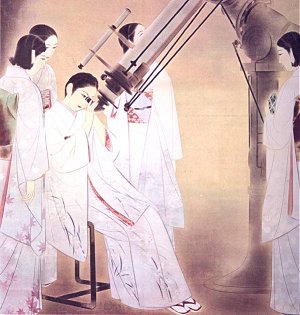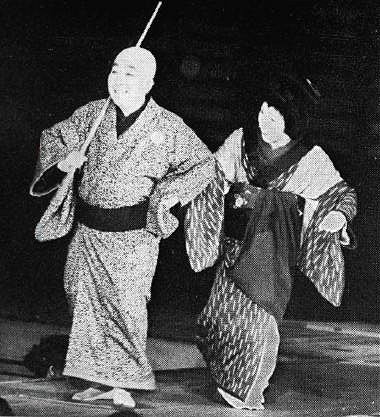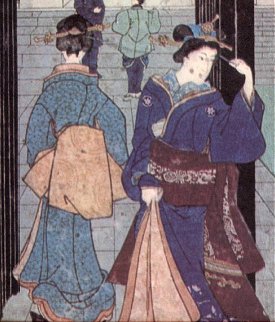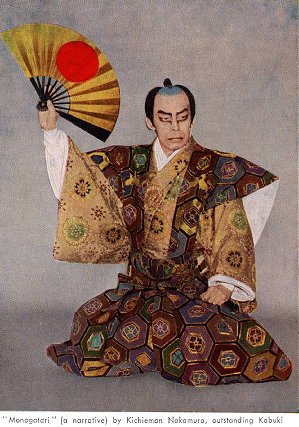|
The simplest way of dressing is to only wear a single cotton kimono, printed in one color -- blue, black, red, or brown -- on white, called a yukata. This requires only a single himo around the hips, the place all kimono are anchored. Quit thinking waist ties. A tie around the waist is tied around soft tissue, and as the wearer moves and bend often becomes untied. Ever notice when you're wearing a bathrobe you have to keep retying it? The pelvis is relatively unyielding, so a tie here will stay put. Wearing a yukata is the exact equivalent of lounging around in your PJ's -- they are worn to bed. Going outside requires more layers. First is the shorts or loincloth men wear. Modern women wear low-slung bikinis, but any damsel who has had to hoist her kimono and obi out of the way in the benjo will be glad to skip the step of getting panties up and down with the non-existent third hand it seems to require. Next comes the white cotton hadajuban, a shortened kimono with narrow sleeves, to which women add a sosomi or underskirt. The left edge (as the wearer sees the sosomi being worn) and the hem will be of some attractive colored crepe, almost always scarlet; the rest is plain cotton. Often the female hadajuban is a narrow-sleeved full-length white kimono with this red fabric on the lower skirt and the front extensions that fills both functions at once. This lets us skip the separate sosomi. Her hadajuban may have a pale aqua neckband: for some reason this is considered flattering with all female dress wear. The neckband and sleeves may also be in scarlet. In some periods, a hadajuban of pure white habutai silk is preferred by ladies. Men may also wear a long hadajuban, especially with dressier kimono. This was normal in kabuki costumes.
Once the hadajuban is tied on, under-kimono may be piled on and himo'ed one by one. Each sleeve will be a little wider, so that the previous sleeve fits inside it. The color of the hem, neckband, and sleeves will be chosen to shade from white to the main color of the main kimono. It is perfectly authentic to only wrap and tie on a series of colored neckbands (eri) mounted on a bit of cotton cloth in place of full garments. The fabric pattern and the sleeve length of the kimono are determined by age, sex, current fashions (they vary down the centuries), and what the wearer is going to do in the kimono. Doing the wash takes a kosode (narrow-sleeved) yukata over hadajuban; full dress-to-impress is the most ornate fabric and the widest sleeves suitable for one's age. Red and pink are the colors for girls and young women. They also wear the widest sleeves (furisode). Kelly's sleeves should be so wide they trail a bit, if we're talking dress kimono. Stacie's sleeves should touch ground or nearly so. Skipper's or Teen Skipper's should be below her knees. Naturally for everyday wear they should be more practical. Brown and indigo are suitable for older people, or any work day. Also, the younger the person, the bolder the patterns; the older the wearer is, the more they wear tiny foulard-type prints or weaves. Over the main kimono goes a stiffened or stiffly-woven obi, more or less decorative. A simple man's obi may be plain indigo; we've all seen the gorgeous brocade obi of a woman's full-dress wear. A man wears his around the hips, a woman around the waist. Over her obi she wears an obi cord. If the obi stands too far away from her chest, or just for decoration, she fills in the top with an obi scarf.
Now, with a pair of tabi (split-toed socks) and sandals, the outfit is ready
for the street. When a man really dresses up, he wears hakama (wide trousers) and kataginu (winged vest). No hakama always indicates a certain level of informality. However, in Tokugawa times this had a caste limit: only samurai wore the kataginu and hakama. Sumptuary laws! It's like the law that only samurai could carry the dai-sho (two swords). Chonin, townsmen, were limited to no more than a wakazashi(short sword) and ordinarily just had the tanto (knife). Wealthy businessmen wore kimono with haori (coat) or hapi (jacket) in very fine fabrics to dress up, but it would not be appropriate to put them in anything at all metallic or even too gaudy.
We won't go into the kataginu or hakama of formal wear. Pants and such require other patterns. Neither will we cover lined and padded kimono.
Barbie® is a registered trademark of Mattel®, Inc. Gene® is a registered trademark of Mel Odom and Ashton Drake. Candi® is a registered trademark of Hamilton Designs. Tyler Wentworth® is a registered trademark of the Robert Tonner Doll Company. Any other dolls mentioned are registered trademarks of their respective owners. This website and those who maintain it are in no way affiliated with the any above mentioned parties. The images of the dolls displayed are photos taken by the author(s) of the article and/or the designer featured. Please do not remove pictures and/or text from this website without permission of the webmaster and/or the photographer. |




